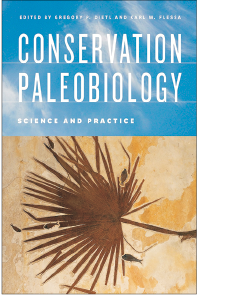

 Conservation
informed by the fossil record
Conservation
informed by the fossil record
Gregory P. Dietl and Karl W. Flessa (eds.) 2017. Conservation Paleobiology: Science and Practice. 336 pp. University of Chicago Press, Chicago. ISBN 978-0-226-50672-2 (paper). Price $40.00; e-book $10.00–40.00.
Humans have become the major force transforming Earth and its biota. Centuries of anthropogenic pressures combined with the dynamic nature of biological systems represent a significant challenge to conservation biology. What was the “pristine” state of altered ecosystems for which we lack long-term monitoring data? Are fluctuations in species abundances a harbinger of transition to less stable ecosystem states or just an expression of natural variability? The emerging field of conservation paleobiology offers a long-term perspective necessary to answer such questions by using data from the fossil record to guide conservation and restoration efforts.
The new book Conservation Paleobiology: Science and Practice edited by Gregory Dietl and Karl Flessa provides a comprehensive overview of the methods, applications, success stories and challenges of this rapidly growing discipline. This compilation of fourteen chapters, written by 26 established experts in the field, represents an extended reprint of the proceedings of a short course on this topic originally published in 2009 as volume 15 of The Paleontological Society Papers.
The book is organized into three thematic sections. The first part, Conservation Paleobiology in Near Time, is devoted to interdisciplinary approaches aimed at extracting and interpreting geohistorcal data from the most recent geological record (< 2.5 Ma). Multiple case studies used to illustrate them encompass a diverse set of aquatic, terrestrial and marine habitats, and target taxonomic groups ranging from diatoms to condors. Chapter 1, by M. Kowalewski, summarizes eco-environmental information that can be extracted from shells of macro-invertebrates. Chapter 2, by J.P. Smol, reviews the application of paleolimonlogy to conservation problems. In Chapter 3, E.A. Hadly and A.D. Barnosky outline conservation-relevant research strategies of vertebrate paleontology, including population genetics based on ancient DNA. In Chapter 4, S.T. Jackson and colleagues provide an excellent example how long-term ecosystem dynamics reconstructed from paleoecological archives can inform natural-resource management in the Rocky Mountains. In Chapter 5, J.B.C. Jackson and L. McClenachan demonstrate how centuries-long human exploitation of marine resources has shifted baselines for restoration. Chapter 6, by P.L. Koch and colleagues, is a primer on the application of stable isotopes for studying the ecology and physiology of extant and fossil vertebrates. In Chapter 7, S.M. Kidwell discusses the utility of time-averaged death assemblages for recognizing human impacts in marine ecosystems. Finally, in Chapter 8, S.K. Lyons and P.J. Wagner suggest ways in which macroecological methods can be used in conservation contexts.
The collection of essays in Section 2, Conservation Paleobiology in Deep Time, is more theoretical in nature and focused on fundamental processes shaping Earth’s biota. In Chapter 9, G.J. Vermeij, offers a deep-time perspective on the consequences of extinctions, invasions and environmental change. In Chapter 10, R.B. Aronson examines the hypothesis of scale independence of predator–prey interactions and its implications for the fate of the Antarctic benthic fauna. In Chapter 11, P.D. Roopnarine presents a mathematical model for the reconstruction and analysis of paleocommunity food webs. The last two chapters by G.P. Dietl and W.D. Allmon, highlight the anthropogenic alteration of selective regimes and its long-term effects on the evolution of biotic interactions and speciation.
I found the final section, Conservation Paleobiology at Work, by far the most fascinating part of this book. K.W. Flessa’s personal account of transition from taphonomy to conservation-oriented research in the Colorado River Delta, is followed by a roundtable discussion by five conservation paleobiology practitioners. They describe the application of their work in conservation practice and offer their firsthand experiences in engaging with agencies, non-governmental organizations and local communities. Such nitty-gritty details of translating the results of basic research into practical solutions of real-word problems are utterly missing from conventional academic training.
Throughout the book, echoes an idea that traditional conservation strategies aimed at preservation of the status quo may no longer be feasible in rapidly changing, human-dominated word. Novel approaches such as assisted migration and rewilding remain controversial and the authors underscore the importance of paleontological perspective in guiding their potential implementation. In this respect, it is a pity that the application of fossil data in invasion biology and species distribution modeling is only briefly mention, in spite of recent progress in these fields. Admittedly, as a reprint of the volume first published almost a decade ago, this book cannot represent the most up-to-date synthesis of the rapidly developing discipline. Luckily, the newly added introduction and prefaces to the sections refer a reader to the most recent reviews of the topic.
In summary, Conservation Paleobiology represents an excellent book worth reading by anyone interested in paleontology, ecology, conservation biology or environmental science. I am convinced that it will serve as an authoritative review and inspire new research ideas for years to come. Most importantly, it provides a blueprint for a new, exciting paleobiological research program that, while addressing fundamental questions in ecology and evolution, directly tackles most urgent challenges faced by the modern society
Rafał Nawrot [rnawrot@flmnh.ufl.edu], Florida Museum of Natural History, University of Florida, 1659 Museum Road, Gainesville, FL 32611 USA.
Acta Palaeontol. Pol. 63 (4): 736, 2018
http://doi.org/10.4202/app.00549.2018